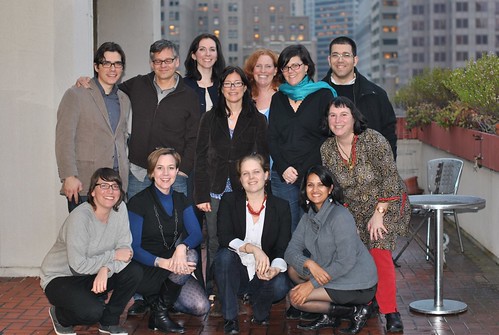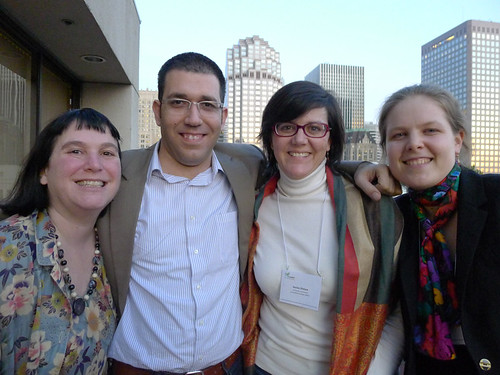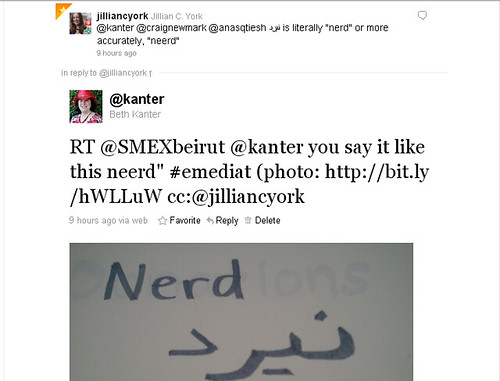
Last week, I participated in three very intense days of project, curriculum, and online community planning for a new project, E-Mediat, a multi-stakeholder capacity building project for NGOS and Social Media in the Middle East. This is the first of a three-part post about the planning meetings.
I’ll be sharing insights about the project as it unfolds — it is going to be a rich opportunity for learning because it is a capacity building project that leverages a networked approach. I’m the lead for Zoetica, an implementation partner for this project where my role is to deliver training, advise on the curriculum and coaching methods, model transparency, and serve as a sort of meta network weaver.
The E-Mediat project is sponsored by MEPI, US Department of State’s Middle East Partnership Initiative and was created in response to Secretary Clinton’s announcement of Civil Society 2.0. The project is being managed by IIE and builds on a highly successful program launched in the Middle East five years ago, Women in Technology that trained over 10,000 women from 9 countries in the Middle East and in collaboration with over 60 training partners. A true public/private partnership, the funding partners include Microsoft and craiglist Charitable Fund.
In addition to Zoetica, implementation partners include SMEX Beirut, TechSoup Global, and Meedan, plus a network of in-country teams and training partners. The goal is to train over 150-250 NGOs in Jordan, Lebanon, Yemen, Morocco, and other countries and help them put social media skills into practice.
The plan for the next year is:
- Train and develop 12 leaders from the MENA region (4 Strategic Advisors, 4 Country Directors/Master Trainers and 4 Training Coordinators) = In-Country Leadership Teams
- Deliver targeted, cutting-edge social media training and coaching to 150 – 250 NGOs and CSOs in 15+ communities
- Build the capacity of these NGOs and CSOs to use new media effectively through mentoring and coaching
- Provide digital infrastructure to the 150 – 250 organizations through a public-private partnership with Microsoft
- Develop a Multilingual Online Learning Community for partners, contributors, sponsors, participants, teams, mentors, social media techies from the region, and trainers to interact and share best practices
- Establish local networks of individuals and organizations using social media to help build stronger organizations and more participatory societies

A big reason for our three day meeting was for the four of us who are creating the “Train the Trainers” workshops for the in-country leadership teams in Beirut next month to meet and finalize our lesson plans and materials. As part of working in a transparent way, the curriculum is available on a wiki and creative commons license.
Insight #1: Build Time for Getting To Know Each Other At The Beginning

Multi-stakeholder projects with many organizations, people, and roles are complex. In some cases, partners will not have met face-to-face before they work together. It is important to have a face-to-face meeting to get started and most importantly to build relationships and trust. This is especially important when you are working cross-culturally.
Our first day of meetings devoted most of the morning for team building and orientation. The implementation team was in the conference room in San Francisco for the first time, plus we had in-country leaders on Skype and phone. This team building is very important to building trust and understanding – as you can imagine we’re coming from different cultures and levels of understanding – and we haven’t worked together before … so opportunities to get know each other, both through ice breakers and sharing a meal together.

I designed an icebreaker that allow us collectively to build an network. Everyone was asked to share five words or “hash tags” on sticky notes and place them on the wall. Each person introduced their: “Five Things You Should Know About Me” for this project. This allowed each of us to share what we’d like others to know – what we bring to the project and what we’d like to learn.
We created a network map. Networks are more than random gatherings of people and organizations online. People can be connected in networks through their knowledge or skills or interests. The key to networks is connections and reciprocity. That builds relationships or social capital – the glue that holds networks together.
The debriefing question encouraged us to reflect on points of connection and reciprocity.
- What points of connection (common interests) did you hear or see?
- What opportunities for reciprocity?
Some Connection Points:
Learning
Passion
Efficiency
Success
Building on a five-year investment
Reciprocity:
Non-technical and Nerds – can help learn
Experience with Middle Eastern Culture and no experience

When the Ryan Sweeney, Program Assistant and techie at IIE introduced himself, he used the word “Nerd.” We asked the team leaders if there was an Arabic translation. They told us that the phrase is understood to mean someone who is very smart, but there was not an actual an Arabic word for “nerd.” We tweeted about this using the #emediat hashtag and it prompted an interesting discussion about Arab transliteration.
What of the things I observed was how well the project leader, Heather Ramsey, from IIE, artfully facilitated a participatory processes — a process that included difficult, authentic, and inspiring conversations about what everyone was passionate about around the table: the power of social media in the hands of NGO to make the world a better place. As Daniel Ben Horin from TechSoup observed during the meeting, IIE approach is something we can all learn from.
My friends from SMEX.org, Jessica Dherre and Mohamad Najem shared this post about their visit to SF. I will be reporting on the process we used to plan for the online community and a VIP Luncheon tomorrow. But as they say in Lebanon, “Yella” (time to go)
